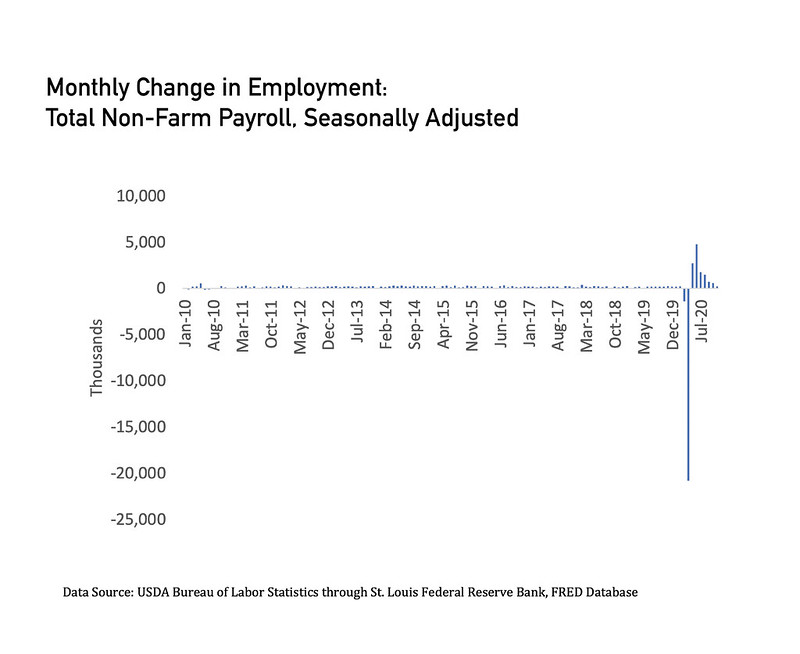Dec. 11, 2020
Employment continues to recover, but at steadily decreasing rate
By Mary Hightower
U of A System Division of Agriculture
Fast facts:
- November employment rises, but gains slowing
- Retail sector shows less hiring of holiday labor
- Transportation, warehousing sector jobs grow
(485 words)
(Download this story in MS Word format here.)
FAYETTEVILLE, Ark. — November employment figures fell short of seasonal expectations expressed before a Dec. 4 report from the Bureau of Labor Statistics, according to an analysis from the University of Arkansas System Division of Agriculture. The employment numbers, usually buoyed by anticipated holiday retail sales, grew only mildly from those in October.
Non-farm payrolls grew 245,000 jobs in November, but that was a lower rate than the 610,000 jobs added in October. Cumulative growth in payrolls for May through November amounts to 12.3 million jobs, against 22.2 million jobs lost in March and April, when the COVID-19 pandemic began shuttering businesses in the United States.
The overall unemployment rate dropped to 6.7 percent in November from 6.9 percent in October.
The November jobs “report fell well short of expectations, with most pre-report analysts looking for job growth in excess of 400,000 new jobs in November,” John Anderson said.
Anderson is an agricultural economist for the Division of Agriculture and head of the Agricultural Economics and Agribusiness Department for the Dale Bumpers College of Agricultural Food and Life Sciences. Anderson has been providing ongoing analysis of the impacts of the COVID-19 pandemic on the U.S. economy.
Shifting retail expectations
Private-sector employment gains were relatively widespread, except for retail, which posted a decline of 34,700 jobs in November.
“Normally, November would witness a significant surge in retail sector jobs as that sector staffs up for the Christmas season,” he said.
“This month’s data suggest that retailers are not staffing up at the normal rate,” Anderson said. “Whether this means they are anticipating a disappointing sales season or just less in-person traffic is not clear.”
He did note that the transportation and warehousing sector added 145,000 jobs in November.
That’s “more than twice the rate of hiring from the prior month and by far the largest November gain in that sector going back to the beginning of that data set in 1972,” Anderson said. “This underscores the significant changes in consumer shopping patterns that have resulted from the pandemic and suggests that these changes will carry though the Christmas shopping season – and, most likely, well beyond.”
November’s clues for future employment
The Bureau of Labor Statistics report contains both the official unemployment rate and the rate of “discouraged workers” — people who would prefer to be working but are not actively looking for a job. This rate dropped one-tenth of a percentage point, to 12 percent. By comparison, this rate topped out at 22.8 percent in April.
Anderson said the rate of the discouraged worker group has generally followed the official employment rate.
“This suggests that workers have not generally become discouraged to the point of dropping out of the workforce in large numbers,” he said. “The relatively small change in workforce participation in November doesn’t reverse that trend, but it is an issue that will bear watching in the coming months.”
To learn more about extension and research programs in Arkansas, visit https://uada.edu/. Follow us on Twitter at @AgInArk, @uaex_edu or @ArkAgResearch.
About the Division of Agriculture
The University of Arkansas System Division of Agriculture’s mission is to strengthen agriculture, communities, and families by connecting trusted research to the adoption of best practices. Through the Agricultural Experiment Station and the Cooperative Extension Service, the Division of Agriculture conducts research and extension work within the nation’s historic land grant education system.
The Division of Agriculture is one of 20 entities within the University of Arkansas System. It has offices in all 75 counties in Arkansas and faculty on five system campuses.
Pursuant to 7 CFR § 15.3, the University of Arkansas System Division of Agriculture offers all its Extension and Research programs and services (including employment) without regard to race, color, sex, national origin, religion, age, disability, marital or veteran status, genetic information, sexual preference, pregnancy or any other legally protected status, and is an equal opportunity institution.
# # #
Media Contact: Mary Hightower
Chief Communications Officer
University of Arkansas System Division of Agriculture
mhightower@uada.edu
501-671-2006
